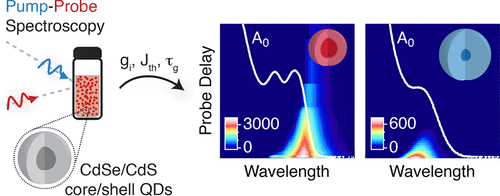Our official English website, www.x-mol.net, welcomes your
feedback! (Note: you will need to create a separate account there.)
The Impact of Core/Shell Sizes on the Optical Gain Characteristics of CdSe/CdS Quantum Dots
ACS Nano ( IF 15.8 ) Pub Date : 2018-09-07 00:00:00 , DOI: 10.1021/acsnano.8b02493 Suzanne Bisschop 1, 2 , Pieter Geiregat 1, 2 , Tangi Aubert 1, 2 , Zeger Hens 1, 2
ACS Nano ( IF 15.8 ) Pub Date : 2018-09-07 00:00:00 , DOI: 10.1021/acsnano.8b02493 Suzanne Bisschop 1, 2 , Pieter Geiregat 1, 2 , Tangi Aubert 1, 2 , Zeger Hens 1, 2
Affiliation

|
Colloidal quantum dots (QDs) are highly attractive as the active material for optical amplifiers and lasers. Here, we address the relation between the structure of CdSe/CdS core/shell QDs, the material gain they can deliver, and the threshold needed to attain net stimulated emission by optical pumping. On the basis of an initial gain model, we predict that reducing the thickness of the CdS shell grown around a given CdSe core will increase the maximal material gain, while increasing the shell thickness will lower the gain threshold. We assess this trade-off by means of transient absorption spectroscopy. Our results confirm that thin-shell QDs exhibit the highest material gain. In quantitative agreement with the model, core and shell sizes hugely impact on the material gain, which ranges from 2800 cm–1 for large core/thin shell QDs to less than 250 cm–1 for small core/thick shell QDs. On the other hand, the significant threshold reduction expected for thick-shell QDs is absent. We relate this discrepancy between model and experiment to a transition from attractive to repulsive exciton–exciton interactions with increasing shell thickness. The spectral blue-shift that comes with exciton–exciton repulsion leads to competition between stimulated emission and higher energy absorbing transitions, which raises the gain threshold. As a result, small-core/thick-shell QDs need up to 3.7 excitations per QD to reach transparency, whereas large-core/thin shell QDs only need 1.0, a number often seen as a hard limit for biexciton-mediated optical gain. This makes large-core/thin-shell QDs that feature attractive exciton–exciton interactions the overall champion core/shell configuration in view of highest material gain, lowest threshold exciton occupation, and longest gain lifetime.
中文翻译:

核/壳尺寸对CdSe / CdS量子点光学增益特性的影响
胶体量子点(QD)作为光学放大器和激光器的活性材料极具吸引力。在这里,我们解决了CdSe / CdS核/壳量子点的结构,它们可以提供的材料增益以及通过光泵浦获得净激发发射所需的阈值之间的关系。根据初始增益模型,我们预测减小在给定CdSe核周围生长的CdS壳的厚度将增加最大的材料增益,而增加壳的厚度将降低增益阈值。我们通过瞬态吸收光谱法评估了这种折衷。我们的结果证实,薄壳量子点具有最高的材料增益。与模型定量一致,核和壳的尺寸对材料的增益影响很大,范围从2800 cm –1适用于小于250 cm –1的大芯/薄壳QD适用于小型核/厚壳QD。另一方面,没有期望厚壳QD大幅降低阈值。我们将模型和实验之间的这种差异与随着壳厚度的增加从有吸引力的激子相互作用向排斥的激子相互作用的过渡联系起来。激子-激子斥力所引起的光谱蓝移导致受激发射与更高能量吸收跃迁之间的竞争,从而提高了增益阈值。结果,小核/厚壳QD每个QD最多需要3.7次激发才能达到透明,而大核/薄壳QD仅需要1.0次激发,这通常被视为双激子介导的光学增益的硬性限制。
更新日期:2018-09-07
中文翻译:

核/壳尺寸对CdSe / CdS量子点光学增益特性的影响
胶体量子点(QD)作为光学放大器和激光器的活性材料极具吸引力。在这里,我们解决了CdSe / CdS核/壳量子点的结构,它们可以提供的材料增益以及通过光泵浦获得净激发发射所需的阈值之间的关系。根据初始增益模型,我们预测减小在给定CdSe核周围生长的CdS壳的厚度将增加最大的材料增益,而增加壳的厚度将降低增益阈值。我们通过瞬态吸收光谱法评估了这种折衷。我们的结果证实,薄壳量子点具有最高的材料增益。与模型定量一致,核和壳的尺寸对材料的增益影响很大,范围从2800 cm –1适用于小于250 cm –1的大芯/薄壳QD适用于小型核/厚壳QD。另一方面,没有期望厚壳QD大幅降低阈值。我们将模型和实验之间的这种差异与随着壳厚度的增加从有吸引力的激子相互作用向排斥的激子相互作用的过渡联系起来。激子-激子斥力所引起的光谱蓝移导致受激发射与更高能量吸收跃迁之间的竞争,从而提高了增益阈值。结果,小核/厚壳QD每个QD最多需要3.7次激发才能达到透明,而大核/薄壳QD仅需要1.0次激发,这通常被视为双激子介导的光学增益的硬性限制。











































 京公网安备 11010802027423号
京公网安备 11010802027423号